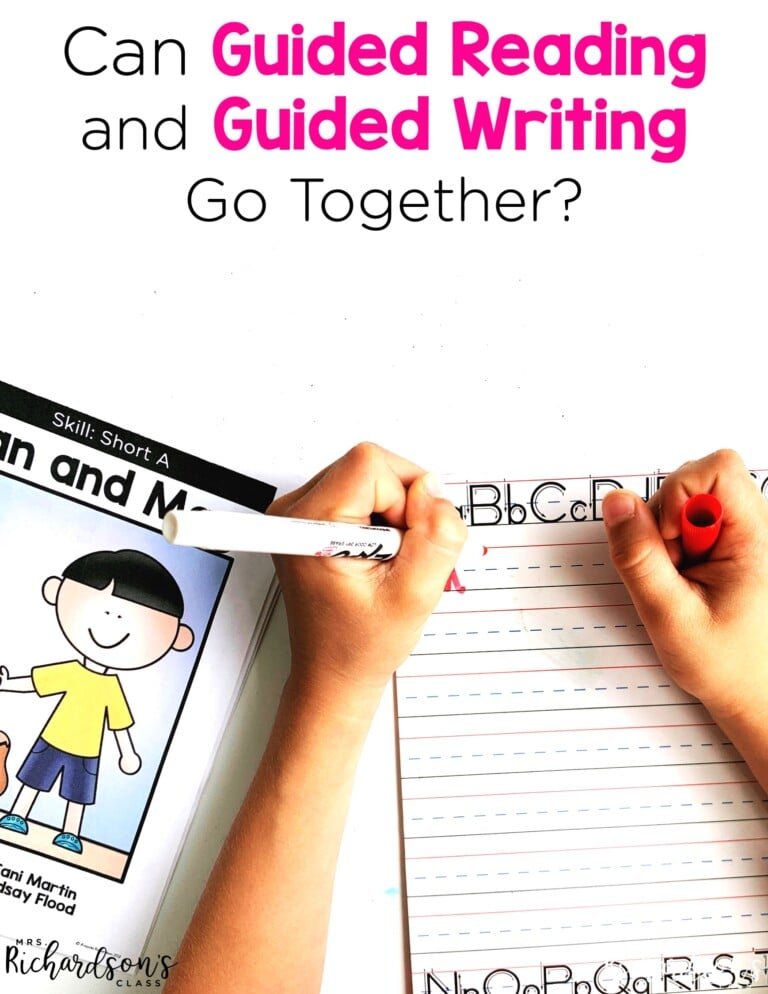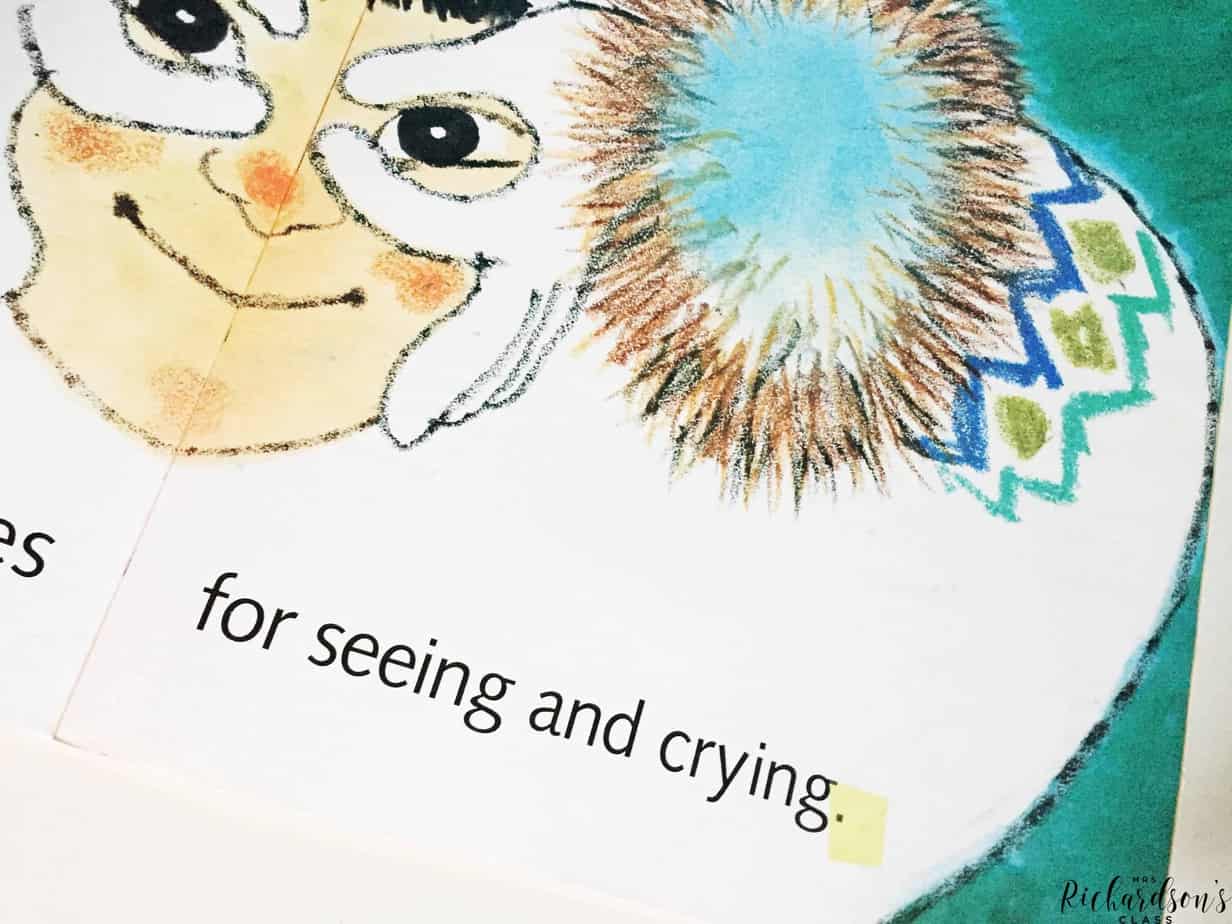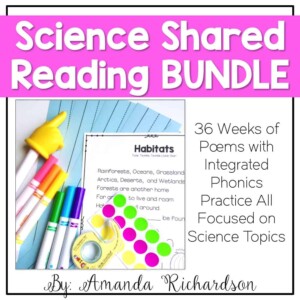

Shared reading is always one of my favorite parts of the day. It’s a part of a balanced literacy approach where students and the teacher read a text together and practice a reading skill. The teacher chooses a teaching point to model, and the students get to practice it each day. If your teaching points for shared reading are strong and meaningful, then this can be a powerful chunk of time in your day! Shared reading is a great opportunity to provide support to struggling readers, build fluency and sight word knowledge, and allow students to enjoy a text that they feel successful reading. Kids love songs and poems!
If you aren’t sure what shared reading is or you want to brush up on it, you may want to check out THIS post.
Here are five teaching points for shared reading that you could use with any song, poem, or big book to encourage your students in their reading progress throughout the year:
Using pointers, you can model pointing to each word of the poem as you read. Then, have different students come up and be the pointers throughout the week. I like to pick students who really need the extra opportunity to practice this specific skill. We also put dot stickers under each word of the poem. This helps with one-to-one correspondence. We use one sticker for one word. This can be tricky because often times early readers assume that words and syllables are equivalent. I have to be sure to show them that they shouldn’t move to the next word until we have said the whole word.
You can use highlighter tape to identify letters, words, and sentences in the poem and discuss the differences in each.
For example, “Who can come find the letter s?” or “Who can find our new sight word ‘see’?” or “Who can point to a whole sentence for us?”
Students could find a letter in their name and sight words to squeeze in extra practice.
Using highlighter tape, mark all of the punctuation in the poem.
For example, “How do I know where to stop reading? Is it when I get to the end of the line?” “No! When you see a period.” (We always started with periods in Kinder and then moved on to question marks and exclamation marks from there.)
You can discuss what they mean, what our reading voices do at each type of punctuation, and they can come up with their own sentences to share with a given punctuation mark. If you use punctuation songs, this is a great time to practice them.
Before reading the poem, ask students to make predictions based on the title, any illustrations, and/or the first or last sentence of the poem. With a big book this is simple–just keep the book closed! With a poem, I like to cover up the words and leave just the title showing because I always have little ones who want to read ahead.
I say, “Let’s read the title and make a prediction!” “Super! Who would like to make a prediction? What do you think this poem/book will be about?”
This is a great opportunity to model thinking like a reader!
The more familiar our learners are with a text, the easier it is for them to practice expression. After modeling, students will practice reading with correct expression all week. This really helps improve their overall fluency and allows for reading with an authentic purpose.
You could use these five teaching points for shared reading each week if you need to. It’s important to remember that, as with all teaching, this is FLEXIBLE. If you see something else your students need to practice, just replace one of these teaching points with what your students need.
I also want to share my Shared Reading Poetry Bundle that is perfect to integrate science with literacy.

Shared reading is such a valuable part of the day where we can integrate science, poetry, fluency, and phonics all in a 15 minute time frame! What are your favorite teaching points for shared reading?
pin it

Want to use the latest research to boost your readers during small groups? This FREE guide is packed with engaging ideas to help them grow!

I’m a K-1 teacher who is passionate about making lessons your students love and that are easy to implement for teachers. Helping teachers like you navigate their way through their literacy block brings me great joy. I am a lifelong learner who loves staying on top of current literacy learning and practices. Here, you’ll find the tools you need to move your K-2 students forward!


| Cookie | Duration | Description |
|---|---|---|
| cookielawinfo-checkbox-analytics | 11 months | This cookie is set by GDPR Cookie Consent plugin. The cookie is used to store the user consent for the cookies in the category "Analytics". |
| cookielawinfo-checkbox-functional | 11 months | The cookie is set by GDPR cookie consent to record the user consent for the cookies in the category "Functional". |
| cookielawinfo-checkbox-necessary | 11 months | This cookie is set by GDPR Cookie Consent plugin. The cookies is used to store the user consent for the cookies in the category "Necessary". |
| cookielawinfo-checkbox-others | 11 months | This cookie is set by GDPR Cookie Consent plugin. The cookie is used to store the user consent for the cookies in the category "Other. |
| cookielawinfo-checkbox-performance | 11 months | This cookie is set by GDPR Cookie Consent plugin. The cookie is used to store the user consent for the cookies in the category "Performance". |
| viewed_cookie_policy | 11 months | The cookie is set by the GDPR Cookie Consent plugin and is used to store whether or not user has consented to the use of cookies. It does not store any personal data. |
6 Responses
I am a pre-service teacher about to do my final prac and I love your site!
Thanks for sharing so many great ideas!
Really impressive ideas thanks for sharing
This is so helpful! I am new to 1st grade and need all the help I can get. I’ve already purchased and began putting together your amazing Guided Reading Bundles. (You rock!) Any chance you might make a Social Studies Shared Reading Bundle?☺️ I will be teaching ELA and SS.
Hi Jan! I am so happy to hear that! You are not the first person who has asked about social studies shared reading. Maybe one day I’ll get around to that. 🙂